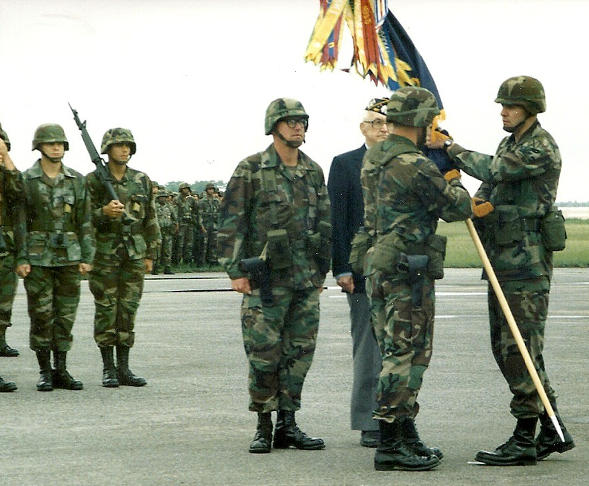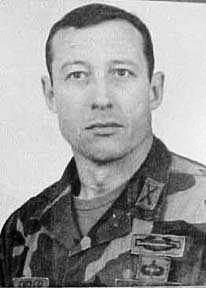![]() 1st Battalion 22nd Infantry
1st Battalion 22nd Infantry ![]()
|
Activation
of 1-22 IN at Ft. Drum, NY |
|

LTC Robert Hensler
Commanding Officer of 1st Battalion 22nd Infantry receiving the
Colors of 1-22 IN
from COL Jack Keane, Commander of 1st Brigade 10th Mountain
Division June 1986 at Fort Drum, New York.
Photo courtesy of COL Robert Hensler
by Colonel
Robert Hensler
Commanding Officer 1-22 Infantry 1985-1987
The 1-22nd was realigned with the 10th Mtn Div from the 4th ID in the 1984-85 timeframe. The 1st Bn colors were stood down at Ft. Carson and sent to an Army depot. Prior to activating we received all the Regimental historical items, like the Ft. Keogh punch bowl, colors, etc.
There had been a 22nd Regt of Militia stationed at Madison Bks on Lake Ontario near present day Watertown, NY (Watertown is the largest town closest to Ft. Drum) after the War of 1812. This was most likely the organization that Winfield Scott commanded during the Battle of Chippewa in 1814 wherein the motto "Regulars By God" was born.
Interestingly enough, there was a high school in Watertown (circa 1985) named General Brown H.S. and their motto was "The Regulars." General Brown commanded the regiment sometime during its posting at Madison Barracks. This is, in part, how someone at the Dept. of Heraldry probably associated the 22nd with the Ft. Drum geographical area. It had no association what so ever with the 10th Mtn Div. before that.
The first Bn CO and CSM at Drum (Robert Hensler and Ronald Dumka respectively) arrived at Ft. Drum within a day of each other in August 1985. We had a rare opportunity to sit around, drink coffee, get to know each other and reflect on our shared vision for the future 1-22 Infantry. Our office was a single small cubicle on the second floor of the Division G3 building (old WW II structure). We borrowed a butcher board and proceeded to craft our vision of the organization. From time to time we would share our latest musings with the Div. Chief of Staff, Jack Keane, who was the 1st Bde commander designee. This period of several months was critical, providing us the time to shape many facets of the philosophy that became the battalion’s “personality.”
The core of our vision we called the Pillars of Excellence. This was a reflection of our experiences in previous units plus it drew from a FORSCOM study that identified common traits among acknowledged high performance organizations. The Pillars of Excellence were: lead by example, battle focus, empower subordinates, strong unit identity, caring, high standards and discipline, teamwork and consistency.
1-22 was activated with a small cadre of officers and a mixed bag of both senior and junior NCOs in Nov. 1985. It was also the first Infantry battalion activated at Ft. Drum as part of the 1st Brigade. The 2nd Brigade was simultaneously activating and training up at Ft. Benning and would not join the rest of the division at Drum for a couple years. Over the next two months we received the majority of our NCO chain of command and in about the March '86 timeframe, we picked up all our Lts. Most were brand new 2nd Lts. straight out of Ranger School. The company XOs were 1st Lts. rotating back from Korea.
Our senior NCOs were among the best I ever served with to include two tours in Ranger Bns. The CSM, Ron Dumka, did an incredible job of bringing the NCO support channel together. Their level of professionalism carried the battalion for a long time thereafter. The first sergeants were: John Janatta, HHC, George Douglas, Attack Co, John Tony, Battle Co, and Bobby Henderson, Combat Co.
The entire 11B package of soldiers, approximately 350, all came from the same One Station Unit Training (OSUT) Bn at Ft. Benning. We met with that chain of command prior to the 16 week OSUT cycle beginning. We provided the entire 22nd historical lineage to include designing their PT uniforms. There was no standard Army PT uniform then. OSUT Bns usually created their own and used a local vender to put the logos on the sweats. From day one of their 16 week OSUT training, they were the "Regulars By God." The OSUT Bn chain of command knew the importance of the COHORT concept and went out of their way to help us. The troops were totally indoctrinated in the 22nd's history from day one! Our low density MOS’ arrived as individuals.
The chain of command train up at Ft. Drum was intense and occurred during one of the worst winters in recent years in the local area. Our biggest concern was that the young COHORT (Cohesion, Operational Readiness, and Training) soldiers would see their former drill sergeants as “gods” and think that they had taken a step backwards in development once exposed to the new chain of command. Our senior NCOs saw to it that the entire NCO support channel was ready to physically and psychologically dominate the new Regulars, which they did. The troops were quite impressed with their new NCOs at Ft. Drum…, as well they should have been!
One of the significant advantages of a COHORT unit was that the troops had bonded horizontally for 16 weeks in their squads and platoons. With minor exceptions we kept the squads and platoons intact once they got to Drum. An OSUT platoon became the battalion’s scout platoon. Another one became the support platoon, etc. Our 11C’s did come with that skill identifier if I recall.
The battalion formally activated on a cold windy June day with temperatures in the high 40s! The battalion executed a 15-count manual of arms drill a company at a time (non stop movement) that was spectacular. It annoyed the division commander (he didn’t think we could do it without making fools of ourselves), and he didn’t speak to either the CSM or myself after the ceremony. Talk about getting off to a good start! We were honored to have Cpl Don Chase, Color Corporal of the 22nd Regt. during the early 1920s assist in uncasing the Regimental and battalion colors.
The 1st Brigade commander, Col. Jack Keane, later Vice Chief of Staff of the Army, wanted to get the battalions trained and operationally ready quickly. We adopted a four-month train up once the COHORT package arrived. We felt that this was possible because of the bonding that had already occurred and the synergy to be gained from maintaining unit integrity from OSUT to the TOE battalion.
Our train up placed great emphasis on multi echelon training, not surprisingly, and the NCOs had the lion’s share of the responsibility to pull that off. The company commanders and myself spent a great deal of effort concentrating on the Lts. and the linkage between their specific leader tasks (essentially Skill Level Four tasks from that soldier’s manual) and platoon collective tasks. The first Light Infantry MTP didn’t come out until the 1988 timeframe, so we wrote our own task, conditions and standards. The existing ARTEP manuals were very weak in terms of overtly measurable standards. This proved to be a great learning experience for both the junior NCOs and young officers.
We used this technique after detailed discussions with former members of 1st Ranger Battalion, who had done this in 1974 when that battalion was activated. Two of our company first sergeants had been squad leaders in 1st Ranger Bn during its train up and activation and were invaluable in designing the template we used.
When we were in garrison, which wasn’t too often during that four month train up cycle, we placed a lot of emphasis on individual skill training at all levels in preparation for our next trip to the field. We also conducted a rigorous PT program, mostly accomplished at squad level to bolster junior leader identity with their squads. A couple times a month we would do battalion level PT. CSM Dumka led these sessions. He began with “performance oriented training” on the history of the battalion and regiment. The night before he would alert the 1SGs of the general time period, i.e. Indian Wars, WWII, VN, etc. After the battalion had extended itself into position, he would ask questions like, “How many Germans did Pvt. Marcario Garcia kill when he won the Medal of Honor?” He would pick a position within a squad or platoon, for example “Alpha Tm Ldr, 2nd Sqd, 3rd Platoon, Attack Company” to answer. The company with the most right answers was first in order of march for the run. The 1SGs took this very seriously!
The end of train up external evaluation (EXEVAL) came in early Nov. 1986. It began with a 25-mile road march, transitioning immediately into a defensive mission to execute as the first collective task. The temperature was a balmy 42 degrees at the SP and had dropped to about 18 degrees by the time we hit the RP. Over the next week plus the temperature fluctuated between the high 40s and zero to five above. A sister battalion from the 14th Infantry (part of the Division’s 2nd Brigade at Ft. Benning) provided the evaluators. The one comment that we were most proud of was that “The troops were impervious to the weather and environment...” Col. Keane continuously emphasized that Light Infantry was as much a mindset as anything else. The harsh climactic conditions at Drum had been the perfect ingredient to help forge this tenet.
The week following the EXEVAL the chain of command found itself at Ft. Benning as the evaluator package for the 3-14th Infantry, the second Brigade’s final battalion to complete its train up. The weather in Georgia was definitely to our liking!
We returned from this mission and immediately took the battalion to Ft. Bragg for two weeks of MOUT training. Ft. Drum was very much a “bare bones” post in those days and Bragg offered us the opportunity to conduct additional individual and collective skills that we could not do at Drum.
Following the Bragg deployment the battalion stood down for some well-deserved block leave over the Christmas holidays.
January – March 1987 saw the battalion settling into cyclical sustainment training. We had one challenging mission for the chain of command during that time. A National Guard battalion from Upstate NY, Vermont, NH and Maine (companies were spread across those states) conducted its annual training in northern Quebec, Canada, and we provided the evaluation package. This battalion was unique in that it specialized in winter/mountain operations and had some partnership with Italian mountain troops.
Northern Quebec in March is a very cold place. Temperatures hover in the teens during the day and drop into the 30-40 below zero Fahrenheit range at night. All off road movement was done on snowshoes – average snow depth was about waist high. It was a very interesting and exciting deployment. I had never slept outside in minus 35-degree weather. I still haven’t – actually slept in snow caves, which was quite comfortable except when I had to put on my very cold VB boots and crawl outside to relieve myself!
April and May 1987 consisted of STX lane preparation and execution of a brigade-wide multi echelon training event that included squad, platoon and company STXs, including a platoon live fire assault on a bunker complex.
I turned over command in late May ’87 enroute to take command of 3rd Ranger Battalion.
My experience in 1-22 ranks as one of the top two tours in my 27-year career.
Robert M. Hensler
COL IN (Ret)

LTC Robert Hensler Commander 1-22 Infantry, 4 Nov 1985-23 May 1987
Home | Photos | Battles & History | Current |
Rosters & Reports | Medal of Honor | Killed
in Action |
Personnel Locator | Commanders | Station
List | Campaigns |
Honors | Insignia & Memorabilia | 4-42
Artillery | Taps |
What's New | Editorial | Links |